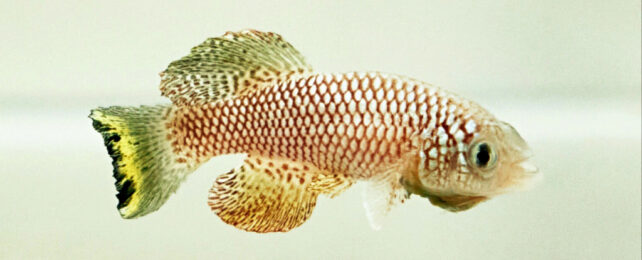ARTICLE AD
 An African turquoise killifish whose embryos can survive, on average, eight months of extreme dry conditions in their native habitat, and up to two years in lab experiments. (Rogelio Barajas/Xiaoai Zhao)
An African turquoise killifish whose embryos can survive, on average, eight months of extreme dry conditions in their native habitat, and up to two years in lab experiments. (Rogelio Barajas/Xiaoai Zhao)
Living in a semi-arid region, the African turquoise killifish has developed a handy biological hack to survive months-long droughts that parch its muddy ponds each year.
The developing embryos of these thumb-long fish just stop growing – not long after their brain and heart begin to form. For months, they hang out in a state of suspended animation, called 'diapause', to wait out lengthy dry spells.
Now scientists have figured out how the African turquoise killifish (Nothobranchius furzeri) manages this drought-defying trick: by co-opting ancient genes buried in its genome that originated more than 473 million years ago.
This finding, from a team of researchers in the US and Germany, is surprising given that N. furzeri only evolved its ability to slip into diapause around 18 million years ago, when it moved into ephemeral ponds.
From the team's analysis of genes expressed in diapause, it seems that acquiring this relatively recent skill involved killifish tapping into some very ancient hardware.
"Even though diapause evolved relatively recently, the genes that are specialized in diapause are really ancient," explains molecular biologist Anne Brunet of Stanford University.
"We found that most of the genes that specialize for diapause in killifish are very ancient paralogs, which means that they were duplicated in the common ancestor of all vertebrates."
Paralogs are pairs of genes created when one gene has been copy-pasted into the genome, either on the same chromosome or a separate one. Aside from random mutations, this genetic duplication is one of the main ways that new genes are generated or acquire new functions.
Brunet's team found that in turquoise killifish, one gene in each paralog pair was highly expressed in diapause, whereas its partner was switched on during active development.
"The whole program is like day and night," Brunet says.
Comparing African turquoise killifish to other killifish species, with and without diapause, the researchers also found that N. furzeri had 'unlocked' parts of its genome to tap into thousands of ancient paralogs for diapause.
Likely looking for ways to adapt to harsh environmental conditions, specialized paralog genes in the N. furzeri genome were made more accessible to the cellular machinery that translates those genes into working proteins.
This genomic remodeling led to a shift in lipid metabolism, whereby African turquoise killifish embryos now make more very-long-chain fatty acids in diapause, which the researchers think could protect their genome from damage.
While killifish embryos don't quite rival tardigrades – microscopic survivalists that can go decades without water because their cells don't shrivel up – their knack for pausing development without harming their half-formed organs by producing lots of lipids is remarkable.
"Killifish are the only vertebrate species that we know of that can undergo diapause so late in development," says Param Priya Singh, a bioinformatician at the University of California, San Francisco who led the study along with computational biologist Adam Reeves, of Stanford University.
"They have a developing brain and a heart which stops beating in diapause and then starts again."
Previous research has shown that this radical suspension of development, at what you'd think would be a critical time, doesn't curtail the lifespan of a fully developed killifish adult.
Now Singh and colleagues say their discovery of the African turquoise killifish's fat-laden survival tactic "opens the possibility for [developing] strategies, including lipid-based interventions, to promote long-term tissue preservation and counter age-related diseases."
The study has been published in Cell.

 5 months ago
39
5 months ago
39 

